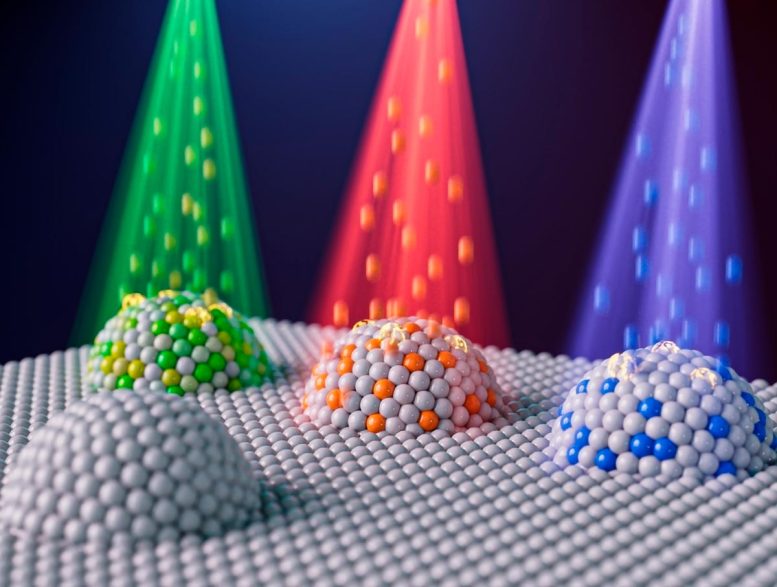
Artist’s representation of nanoparticles with different compositions created by combining two techniques: metal exsolution and ion irradiation. The different colors represent different elements, such as nickel, that can be implanted into an exsolved metal particle to tailor the particle’s compositions and reactivity. Credit: Jiayue Wang
The work demonstrates control over key properties leading to better performance.
“The materials we have worked on could advance several technologies, from fuel cells to generate CO2-free electricity to the production of clean hydrogen feedstocks for the chemical industry [through electrolysis cells],” says Bilge Yildiz, leader of the work and a professor in MIT’s departments of Nuclear Science and Engineering and Materials Science and Engineering.
Critical Catalyst
Fuel and electrolysis cells both involve electrochemical reactions through three principal parts: two electrodes (a cathode and anode) separated by an electrolyte. The difference between the two cells is that the reactions involved run in reverse.
The electrodes are coated with catalysts, or materials that make the reactions involved go faster. But a critical catalyst made of metal-oxide materials has been limited by challenges including low durability. “The metal catalyst particles coarsen at high temperatures, and you lose surface area and activity as a result,” says Yildiz, who is also affiliated with the Materials Research Laboratory and is an author of an open-access paper on the work published in the journal Energy & Environmental Science.
Enter metal exsolution, which involves precipitating metal nanoparticles out of a host oxide onto the surface of the electrode. The particles embed themselves into the electrode, “and that anchoring makes them more stable,” says Yildiz. As a result, exsolution has “led to remarkable progress in clean energy conversion and energy-efficient computing devices,” the researchers write in their paper.
Challenges in Nanoparticle Control
However, controlling the precise properties of the resulting nanoparticles has been difficult. “We know that exsolution can give us stable and active nanoparticles, but the challenging part is really to control it. The novelty of this work is that we’ve found a tool — ion irradiation — that can give us that control,” says Jiayue Wang PhD ’22, first author of the paper. Wang, who conducted the work while earning his PhD in the MIT Department of Nuclear Science and Engineering, is now a postdoc at Stanford University.
Sossina Haile ’86, PhD ’92, the Walter P. Murphy Professor of Materials Science and Engineering at SciTechDaily